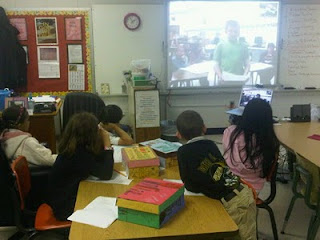
Hello Everyone, it’s been a while. In fact, I haven't blogged since I officially switched from Spanish to Gifted. One of the major changes from my switch is the opportunities I have to incorporate technology. Yes, in Spanish, I used Skype to connect my students to schools in Argentina and Spain, but I was doing all of the talking because I had to translate, which resulted in my students not being able to be as engaged as I wanted them to be. My ideal experience is for my students to steer the conversation and be the ones in charge of the discussion. And, I am thrilled to say that that is exactly what has happened so far with my gifted learners.
Sharing our Work
Just last week I organized a series of Skype sessions with other elementary gifted/talented teachers across the nation. My goal was to have both classes showcase projects that they have worked on this semester. I had my students present one of their projects and in turn they served as a audience for our partner class. I enjoyed watching my students describe their product and was impressed when they started sharing the process of developing these products. I noticed a sense of pride and accomplishment in their voices. It was truly an amazing experience. The best part though was when we had our partner class ask questions and vote on their favorite project. My students really enjoyed receiving this feedback.

Informal Sessions
I also scheduled several informal sessions to introduce both classes. These kinds of sessions were arranged for partner classes that could not Skype for over an hour. For these sessions I also came up with the idea to use a Google map to show both classes where we were. On the Google map, I tagged both schools and used the satellite feature to “zoom” into our schools. Both classes really enjoyed this and thought the satellite view was cool. My plan is to add more partner schools to this map and eventually embed other features such as video greetings or pictures for our partner schools.

The remainder of these informal sessions was dedicated to a Q & A session. Both classes asked questions about their daily life (family, pets), interests, likes (favorite food, music, television shows, toys), and school (special events, recess, classes). I enjoyed watching this dialogue and I know my students were very interested in learning more about our partner classes. And of course, my students were thrilled at the sight of snow!

Overall, my students were excited about connecting with other classes in different parts of the nation. I can tell that these chats have made an impression on them when they ask, “Are we going to Skype today?” Unfortunately, we have to postpone any sessions until January due to end of the semester testing and the holiday break. My students and I are equally looking forward to sharing more projects and good news with our partner schools. This has been as much a learning experience for me as it has been for them. And as our break approaches, I have so many ideas floating in my head. My next step is to find more partner schools as well as develop collaboration projects. If you teach gifted/talented classes in the elementary setting, I welcome you to join us in this journey.


















